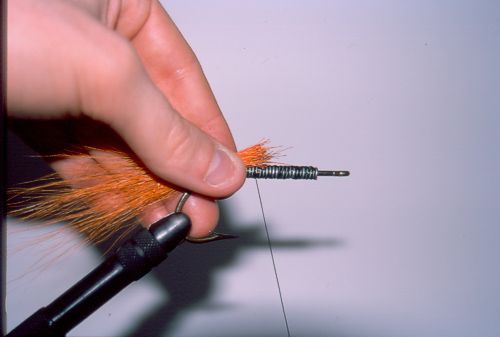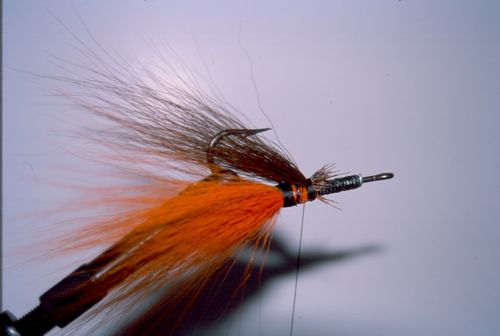Bucktail
Spinnerbait Restoration, Repair and Modification Musky tackle takes a beating and I have yet to meet one angler who pampers their equipment. The fact is, baits wear down and eventually need maintenance to get them back into trophy-catching shape. This article will focus on repairing bucktail spinnerbaits, looking at: tying bucktail, replacing blades, hooks and wire bodies, and painting components. Let's start with the most complex, how-to tie bucktail.
Tying Hair: To repair a bait, first cut the thread collar and remove the old hair. If you plan to reuse the bucktail, remove the thread and glue from the hair so it will tie properly. Next, scrape away any remaining thread or head cement from the tying area. At this stage decide if you need to touch up or repaint the bait's head before tying new hair - I'll cover painting in a separate section.
Prepare to tie by securing the bait in a vise and thread the bobbin. Next,
wind a base layer of thread on the collar if tying hair to the
spinnerbait's head. For trailer hooks, I first wrap wire around the hook
shank; the wire coil provides more surface area to tie to, allowing you to
create bulky bucktails. Next, wind thread around the coil, filling in any
spaces with thread. This prevents thread from catching and breaking during
the tying process. Once a base of thread is applied, rest the bobbin on
the tabletop to prevent it from spinning. Line twist weakens the thread's
tying strength. Apply head cement to the wraps.
Next, position the hair's cut ends on the collar, firmly pinching both the hair and collar. While still holding the hair with one hand, loosely wrap the thread two or three times around the hair with the other hand. Wrap progressively tighter for the next six to eight wraps and slowly release the hair. The sooner you let go and the tighter the wraps, the more the bucktail will flare out. Once the hair is secure, cut away excess hair in front of the wraps, apply head cement, and repeat this process, covering the rest of the tying area. After tying three-quarters of the bait, rotate it 180 degrees in the vise to tie the final section.
After tying the final section, apply extra thread to build the collar. To increase the size and profile of your bait, tie one or two more sections of bucktail in front of the first thread collar. To finish, wrap thread to create a tapered collar, apply head cement, tie a finishing knot and cut loose thread. Blades:
Paint:
Replacing Hooks and Wire Bodies: If the main hook of the body has been cut, or if the bait's wire is twisted beyond repair, purchase a spinnerbait body with hooks and a lead head. Then reuse your old components and the steps above to create new bait for a fraction of the cost of a new one. Repairing your spinnerbaits is not only an excellent way to save money and extend the bait's lifespan, but tying and modifying baits will increase your awareness of how these baits perform. Additionally, small modifications, such as tying in tinsel or treading a grub to a trailer hook, can be the extra detail needed to fool a following muskie.
|



